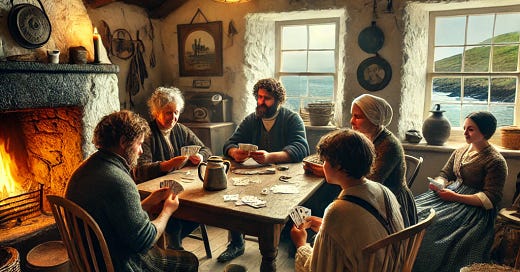The Hebridean "Catch the Ten" Epidemic
In the late 19th and early 20th centuries, the Hebrides, a rugged archipelago off the northwest coast of Scotland, fell under the spell of a card game that seemed to encapsulate the rhythm of island life: Catch the Ten. This humble variation of Scotch Whist became an all-consuming pastime, uniting communities in its grip while subtly redefining how people socialized, worked, and even viewed leisure. During a time when modern distractions were few and life revolved around fishing, farming, and survival, Catch the Ten offered an irresistible escape—a source of joy, rivalry, and camaraderie.
The Game that Took Over a Culture
Catch the Ten wasn’t merely a pastime; it was a phenomenon. Its simple rules and competitive spirit made it accessible to all, from fishermen unwinding after long days at sea to clergy looking for a brief reprieve from their sermons. Played with a standard deck of cards, the goal was to capture high-value cards, with the ten of trumps being the most sought after—a clever mechanic that gave the game its name.
The islanders embraced it with fervor. On stormy winter nights when the wind howled and the sea churned, fireside gatherings often revolved around spirited matches. The game’s addictive nature meant it was rarely limited to a single round; instead, it stretched into marathon sessions that lasted for hours, often well into the early morning. Players displayed their strategic cunning, debated over tactics, and, above all, reveled in the shared experience.
A Social Epidemic
The game’s popularity grew to such an extent that it became nearly impossible to avoid. Visitors to the islands during this period often remarked on how Catch the Ten seemed to dominate every aspect of Hebridean life. Stories abound of fishermen putting off their nets and farmers delaying their plows to indulge in one more game. Even Sunday mornings—a sacred time for most Hebrideans—weren’t safe from its pull. Those who managed to resist the game’s charm found themselves drawn into it nonetheless, either by persistent friends or the sheer inevitability of being in a room where a deck of cards materialized.
In one particularly vivid anecdote, a lonely scholar living in the Hebrides detailed how his plans for quiet mornings with a book were frequently interrupted by neighbors eager for a match. The "demon of Catch the Ten," as he called it, lurked in every footstep approaching his door. Resistance was futile. The game’s enthusiastic players would interpret any reluctance as politeness and cheerfully insist on staying “just for a few hands,” which inevitably turned into an entire day’s commitment.
The Community Glue
While the obsession with Catch the Ten could disrupt daily routines, it also had a profoundly positive impact on the social fabric of the Hebrides. In a world where isolation was a constant companion, the card game became a vital means of fostering connection. Households threw open their doors to neighbors, and the warmth of shared laughter filled homes otherwise quiet from the solitude of island life.
It wasn’t just about the cards; it was about storytelling, banter, and bonding. Friendships were forged, rivalries were kindled, and entire families would gather around the table to cheer, groan, and celebrate. For many, the game offered a sense of unity that transcended the hardships of Hebridean life, where survival often depended on working together.
Obsession or Salvation?
Critics of the time weren’t always kind to the Catch the Ten craze. Some lamented the hours “wasted” on the game, pointing out how it seemed to monopolize evenings better spent repairing fishing gear, tending to livestock, or preparing for the next day’s work. Ministers expressed concern about its encroachment on sacred activities, and a few elders scoffed at its triviality, longing for the days when more traditional forms of recreation, like storytelling or singing, dominated the hearthside.
But for the majority of Hebrideans, Catch the Ten was less a waste and more a reprieve. It provided relief from the harsh realities of island life: unpredictable weather, exhausting labor, and the ever-present possibility of scarcity. In those moments around the card table, with the fire crackling and the sea winds howling outside, the game became an escape. It wasn’t just about catching the ten of trumps—it was about catching moments of joy in a world that often demanded resilience.
The Decline of the Craze
Like all fads, the Catch the Ten obsession began to wane as the 20th century progressed. The arrival of new forms of entertainment, like radio and cinema, gradually took its place as the focal point of leisure. Improvements in transportation and communication connected the Hebrides to the wider world, diluting the insularity that had allowed Catch the Ten to flourish.
By mid-century, the game was still played in pockets of the islands, but its cultural dominance had faded. For older generations, it remained a cherished memory, a symbol of evenings spent in close company, laughter, and the simple joy of shared activity.
A Legacy of Cards and Camaraderie
Though the Catch the Ten craze is long past, its impact on Hebridean culture lingers. It represents a time when community was everything, when the boundaries between neighbors were porous, and when even a simple deck of cards could transform long, dark winters into something lively and memorable.
The story of Catch the Ten is more than just a quirky chapter in Hebridean history; it’s a reminder of how human creativity and connection can thrive even in the most isolated corners of the world. So, next time you pick up a deck of cards, consider playing Catch the Ten. Who knows? You might find yourself tapping into a tradition that once captured the hearts of an entire region.





